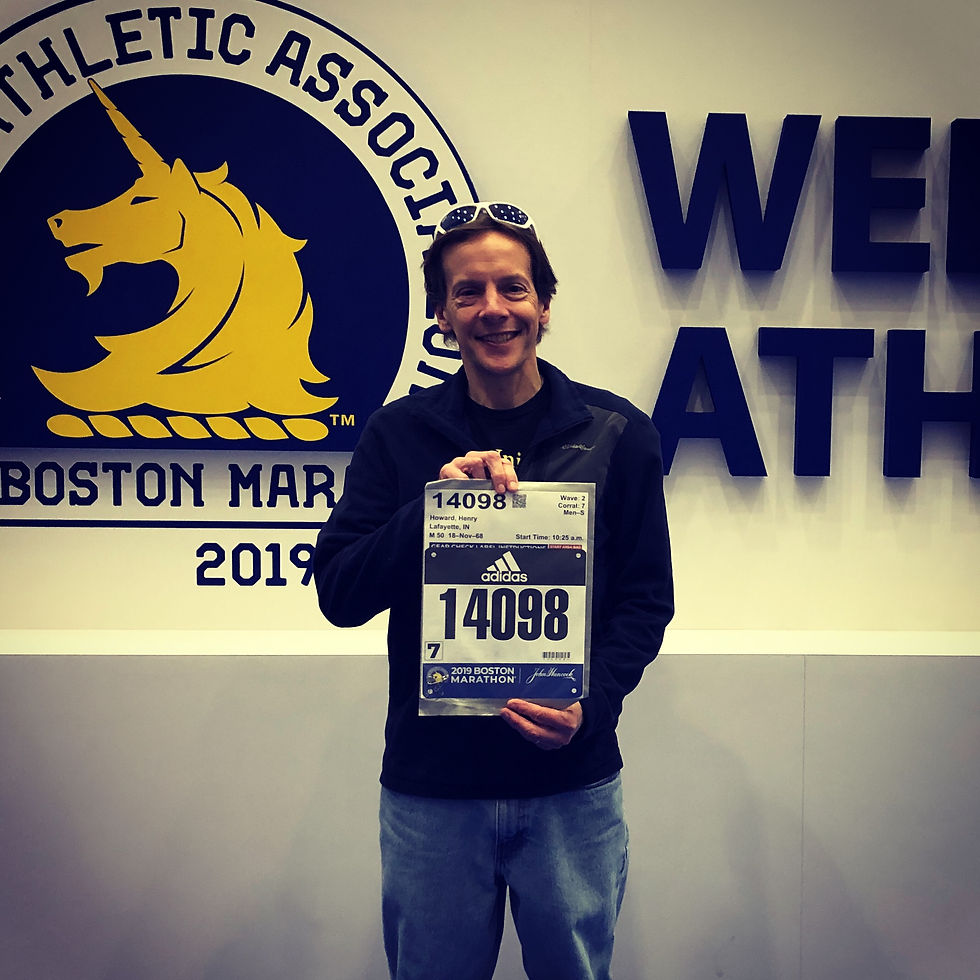A first-timer's guide to the Boston Marathon
- By Henry Howard
- Apr 16, 2019
- 4 min read

Soon after I could put the title “marathoner,” after my name, I became curious about the Boston Marathon. It seemed like a long shot at the time. My first two marathons were just over the four-hour mark, 4:08 for my first and then a 4:07 on my second one.
Still, I set running Boston as a goal. I chipped away at the times, and made a significant leap under the coaching of Angie Spencer of Marathon Training Academy (MTA). When I started with Coach Angie, my PR was 3:53 and I needed a 3:25 to qualify.
It took a couple of years, but I was able to qualify twice. The first time I missed the cutoff by roughly a minute and a half. However, thanks to an age group bump, I had plenty of time to spare when I needed a 3:30 and qualified with a 3:23 at the November 2017 Indianapolis Monumental Marathon.
My reward was the opportunity to achieve that goal. And on April 15, along with 30,000 of my closest, sweatiest and fastest friends, I ran the Boston Marathon. My goal was not to BQ or PR. It was simply to enjoy the race, challenge myself and not injure myself since I have my first 100K in less than four weeks.
Mission accomplished.
Instead of a standard race report, I thought the most useful content for my readers would be to focus on a first-timer’s guide to the Boston Marathon. I learned a lot from my first Boston Marathon. Here’s hoping this list is useful for others making their debut in the future.
1. Plan your stay. Be sure to book your hotel early and do so close to where the expo is held, which is near the finish line. I booked early, thinking that I would get into the race and knowing that I could cancel. I didn’t think a 30-minute ride on the T would be a big deal. But I didn’t calculate the extra time for each trip due to the large crowds. If I could do one thing over again, it would be to pay more for better proximity and convenience.

2. Go to the expo early in the morning before it gets really crowded. There are tons of vendors, of course. It's a great opportunity to learn about new products, gather some samples and learn more about the race. It's also a great time to meet people, including amazing runners like Mike Wardian.
3. Pack everything you could possibly need for the race. When I packed my suitcase, the forecast called for temperatures in the 50s and 60s with a 100 percent chance of rain on race day. The rain was expected throughout the day. However, when we arrived roughly 48 hours before the race start, the prediction began to change. It did rain on us beforehand and after I finished up. While I had various layers with me, all I needed to run was a shirt, shorts, shoes and socks. I bought a visor at the expo because I wanted something to keep the sun and rain out, and I didn’t think the hat I brought would be the best bet. That turned out to be a good call.
4. Pack or buy everything you could need or want while waiting in the Athlete’s Village before the race. Knowing that we would be rained on and there was a high chance of getting my feet muddy, I brought and old pair of running shoes and socks to wear before the race. Once we started walking toward the start line, I changed out of those and left them for the clothing collection. While that worked out well, I did not plan out how I was going to keep dry well enough. The garbage bag I brought didn’t keep me all the way dry and my throwaway sweatshirt became a water-logged wearable sponge. A $7 poncho from the expo would have made a huge difference in my pre-race comfort.
5. Educate yourself. I found it very useful to attend some of the expert sessions and watch the video of the race course. The video plays on an extended loop every half hour at the expo. That was helpful to get a look at the course while various elite runners and coaches talked about each section. If you can run or drive the course beforehand, that would also be invaluable. When it comes to strategy, I took away a ton of good information from Greg McMillan. During a course preview, sponsored by Ucan, Coach McMillan broke down the course into four sections and laid out a good strategy for each. That information really paid off on race day for me.

6. Family meet up. Upon finishing the race, runners walk through a long section to get water, their medals, a heat blanket and a bag of food, before heading to their respective gear checks. Volunteers were especially helpful in directing us to the family meeting areas, which are designated by the first letter of your last name. Since family members are also likely experiencing their first Boston Marathon, plan ahead on where and when to meet. Also have a backup plan. The security was impressive but if something happened, everyone should know where to meet up, just in case.
7. Have fun. You are running an historic race that you probably worked hard in order to run. The crowd support is phenomenal. You may want to try to requalify or set a PR. But things happen on the course. The Newton hills are challenging, even for those who run a smart race. If things go south, smile and focus on the positive — you are running the Boston Marathon.







Comments